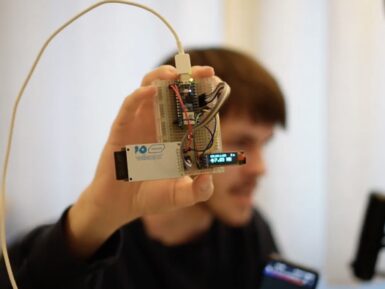
Grove - I2C Hub (6 Port)
Grove - I2C Hub (6 Port) is an I2C expansion interface board, compared with the old Grove - I2C Hub, the same size, two more connectors, almost half the price!
Overview
We've already released the Grove - I2C Hub (4 Port), now comes the 6 port version, the same size, two more connectors, almost half the price!
As you may know, the 7 address length I2C bus allows up to 128 I2C devices to access.
At present, there are over 80 Grove I2C modules in Seeed, however, normally only 1 or 2 Grove I2C connectors are available on the Seeeduino Board or the Grove Base Shield. What if we need to use multi Grove I2C modules in the system? The answer is Grove - I2C Hub (6 Port).
There are 6 Grove connectors in this hub, one input, five output, or you can even connect one hub with another, so that more devices can be plugged in.
Not only I2C but also can be used to control several synchronous change devices (like LEDs).
We did a survey and gathered some feedback about the old Grove I2C Hub (4 Port), many users mentioned that the 4 slots are not sufficient, so we add two more and keep the same 20*40mm size.
SeeedStudio always values the voice of our customers, and we appreciate our customers helping us grow and make us better.
Get Inspired

I have prepare home Automoation project using Arduino nano esp32

Home file servers can be very useful for people who work across multiple devices and want easy access to their documents. And there are a lot of DIY build guides out there. But most of them are full-fledged NAS (network-attached storage) devices and they tend to rely on single-board computers. Those take a long time to boot and consume quite a lot of power. This lightweight file server by Zombieschannel is different, because it runs entirely on an Arduino. An ESP32 is a microcontroller with built-in connectivity (Wi-Fi and Bluetooth). Like all MCUs, it can “boot” and start running its firmware almost instantly. And while it runs, it will consume much less power than a conventional PC or a single-board computer. Zombieschannel’s project proves that the Arduino Nano ESP32 is suitable for a file server — if your expectations are modest. The hardware for this project consists of a Nano ESP32, an SD card reader module, and a small monochrome OLED screen. The SD card provides file storage and the OLED shows status information. Most of the work went into writing the firmware, which Zombieschannel did with assistance from ChatGPT. That has the Arduino hosting a basic web interface that local users can access to upload or download files. Zombieschannel also created a command line interface that provides more comprehensive access via a serial connection. This does have limitations and the transfer speeds are quite slow by modern standards. But the file server seems useful for small files, like text documents. Zombieschannel plans to design an enclosure for the device and it should tuck unobtrusively into a corner, where it can run without drawing much power.








